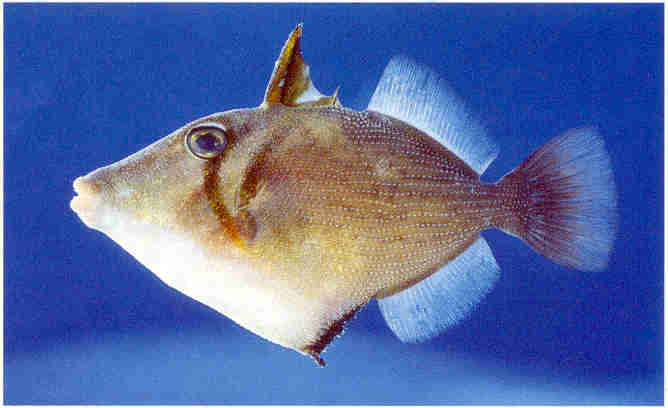
Newsletter of the East Coast Fish-Watch Project No. 3: February 2000

Newsletter of the East Coast Fish-Watch Project No. 3: February 2000
A fish far from home?
by Joan Wright
The JLB Smith Institute was privileged to host visiting scientist Dr Keiichi Matsuura from the National Science Museum in Tokyo for the month of November. Keiichi is a world authority on pufferfishes (Family Tetraodontidae) and trigger-fishes (Family Balistidae). He is writing these family accounts for the forthcoming book, Fishes of the Western Indian Ocean (edited by Phil Heemstra and Jack Randall), hence his visit to the Institute to study these families.
Keiichi was looking through
our fish and slide collections to choose which specimens and photos he
wanted Elaine Heemstra to use for paintings, and at the same time checking
our identifications. One of the tasks I am busy with, is computerising
our marine slide collection, and was thus changing the names of the
fishes on some of the slides according to Keiichi. As I also help
with fish identification, I was intrigued to see that he had changed the
identification of one of our triggerfish, collected on a Fish-Watch dive
at Aliwal in 1998. It was named Sufflamen bursa and he changed
it to Sufflamen albicaudatum. Wanting to see what the difference
was, so that I could pick it up next time, I turned to Smiths’ Sea Fishes,
only to read that Sufflamen albicaudatum was endemic to the
Red Sea! Fortunately Keiichi was working next door and I showed him
the slide and he confirmed that it was indeed albicaudatum.
When I told him that it was caught at Aliwal Shoal, where he
had dived the previous week with the latest Fish-Watch expedition, his
eyebrows nearly hit the roof. He quickly muttered that he must change
his manuscript and rushed to his laptop. Previously, Sufflamen
albicaudatum had only been found in the Red Sea! This kind of discovery
is what makes studying any biological science so rewarding; the boundaries
are forever changing and anyone (not only the scientists) can make a valuable
contribution to our knowledge of fishes.
 |
 |
| Boomerang triggerfish,
Sufflamen bursa.
70 mm; common at Sodwana Bay adults extending south to at least Aliwal Shoal. |
White-tail triggerfish,
Sufflamen albicaudatum
60 mm,from Aliwal Shoal; a new record for southern Africa. |
We are keen for all you divers
and underwater photographers to look out for the white-tail trigger-fish.
The photos above illustrate the differences between Sufflamen bursa,
and S. albicaudatum; note that albicaudatum has a white margin
completely encircling the caudal fin.
The halfmoon triggerfish,
S. chrysopterum is more similar to the white-tail triggerfish, as
the caudal fin has a large, yellow-green or brown crescent with a white
margin on the upper, lower and rear margins of the fin. And, like
S. albicaudatum, it also has a vertical line (white, yellow or black)
from rear edge of eye to below the pectoral-fin base. Adult chrysopterum
are common at Aliwal Shoal, and juveniles have been found as far
south as St Francis Bay.

Sufflamen chrysopterum,
adult, Mauritius; J.E. Randall, photo.
Editor’s note: In Smiths Sea Fishes, these triggerfish names are spelt incorrectly as Sufflamen alibicaudatus and S. chrysopterus. The -us (masculine) ending should be changed to the -um (neuter) ending to agree with the gender of Sufflamen. Likewise the name fraenatus (meaning “bridled”) should be Sufflamen fraenatum. The name Sufflamen bursa stays unchanged, as bursa means “leather” and is thus a noun in apposition to the genus name.
N.B. Please note that with all the images in this and the following articles, a larger image can be seen by right clicking on the image and then clicking on view image.